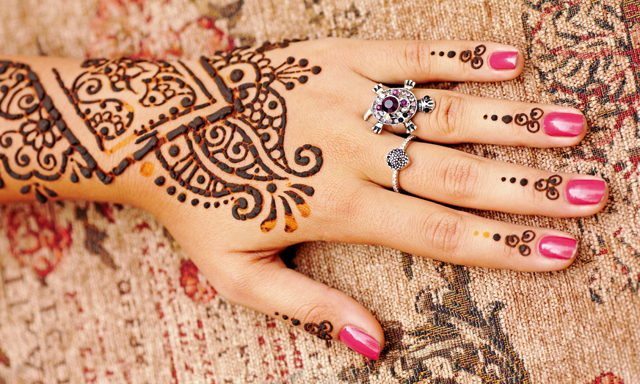On the streets of Abu Dhabi, the sight of women with intricate reddish/brown designs decorating their hands, feet, arms and legs is pretty common. A practice heavily steeped in Emirati culture, henna body art is a popular embellishment with women due to its versatility, aesthetic qualities and safe application. Having been used for centuries, henna is a natural way for women to customise their appearance.
Henna is made from a flowering plant; Lawsonia inermis. This plant has been used since the Bronze age in the Middle East (4th millennium BC), either for dyeing material such as leather and wool, or for colouring hair, nails, hands and feet. The leaves of the plant are collected, dried and then crushed. The leaves are then mixed with essential oils (such as tea tree, lavender or eucalyptus). Sometimes even berries are used and citrus juice. The citrus is very important because it helps turn the flaky mix into a paste, which can be easily administered and manipulated.
The plant has a tannin dye molecule called Lawsone or hennotannic acid. When exposed to protein for a long time, this organic compound binds to it. However, the dye does not penetrate the skin, it merely stains it. This is why henna is tolerated in Islamic societies, because it doesn’t permanently damage the skin.
Henna is incredibly popular in the cultures of the Middle East, India and even in some parts of Africa. Men will also sometimes apply the dye to their hair or beards. Women often adorn the skin on their hands and feet with ornate, intricate designs in commemoration of special occasions or holidays. Many expatriate women in Abu Dhabi try the custom as well, because the designs are beautiful and temporary. Having set up a salon with her sister over nine years ago, Thrupti Gokani tells us how she is seeing increasing numbers of expatriate women ask for the treatment. ‘Our clientele consist of all nationalities, just as Abu Dhabi is full of so many nationalities.’
Her salon, Beautiful Henna Centre, offers Arabic and Indian henna designs, ‘but we only use the natural Indian red henna.’
The local tradition is for women to apply henna onto their hands and feet, featuring mostly flowers. However, Abu Dhabi is full of henna parlours and most with technicians from different nationalities: the result being a broad range of styles and even types of henna. We spoke to Shifna Rameesdeen from Casablanca Ladies Salon about the different styles. ‘The main designs we offer are either Indian or Arabic. The Arabic designs usually have flowers or any circular shapes. The Indian designs are more complex, we use animals and other figures’. There is also the fusion option, which many of the younger expatriate generations seem to enjoy, she says.
The most common and natural henna gives off a reddish hue on the skin. However, there are other mixtures which incorporate some chemicals to yield a range of colours, varying in intensity as well. For example, some places offer the Sudani mix, or the black henna. A word of caution: you should always begin by applying a small patch of henna on your skin and waiting at least 30 minutes before proceeding with the design. Some people have had allergic reactions to certain mixes, although these instances are decidedly rare when using the natural red henna.
Prices range according to the size, the mixture used, as well as the salon where it is administered. As a general rule, a hand or foot will cost between Dhs30-50. For the design to cover the hand and half the arm, the price would go up to Dhs70 per hand. Some women even opt for fake henna tattoos; choosing a small design on the shoulder or lower back. The cost in these cases is a fraction of what a conventional tattoo would be.
Abu Dhabi is full of places that offer henna art. Many ladies salons offer the treatment in addition to their hair and nail services. There are also technicians who will administer it in the comfort of your own home.
Some prefer this, because you often have to wait for up to three hours for the paste to dry properly. If the caked mix is removed too early, the dye won’t be evenly dark across the design, nor will it last very long.
Normally a henna design, done with a good mixture and left to set properly, can last between eight and 14 days. The design fades of its own accord.
To try out a henna design, contact Beautiful Henna Centre (02 634 3963), or Casablanca Ladies Salon (02 634 4505).









